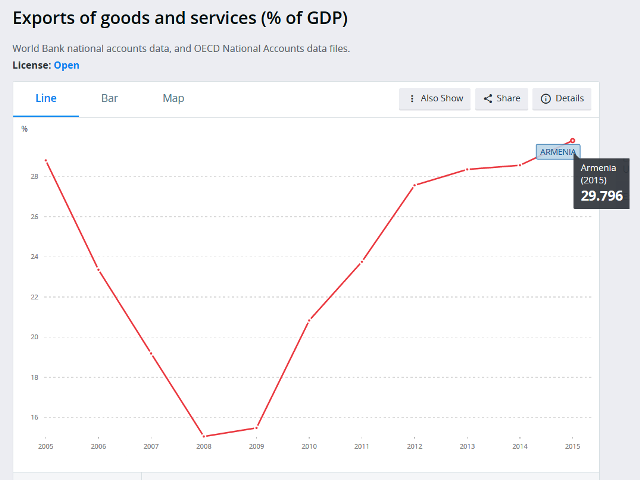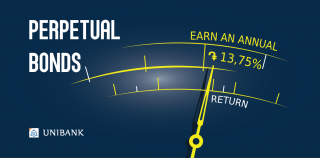
Vision of export: What does the government promise?

Economic year of 2016 wasn’t successful—weak economic activity was recorded—0.5%, and instead of anticipated 2.2% real GDP growth it comprised only 0.2%.
One of bright sides of economic statistics was foreign trade, in particular, export.
Thus, in 2016 export volume from Armenia comprised USD 1 billion 782.9 million. Real export growth compared with 2015 comprised 20%. In the same period import grew by 1.6%. Of course, it was stated that the growth was partially conditioned by low indices of 2015, however, in any case, 20% growth isn’t a bad index.
Indices of foriegn trade for the first two months of ongoing year aren’t bad either. Export continues growing by 20% based on results of January-February. Like in 2016 the growth was mostly conditioned by growth in export to EEU member countries.
What will happen then, by the end of the year, and after it, based on a few years?
In fact, it’s difficult making anticipations, however, instead we may say what purpose the government pursues.
Regarding export government’s vision was reflected first in government’s action plan, and then in RPA pre-election plan.
That part particularly reads, “Armenia, a country with small internal market should build its development model, taking as a basis economic growth conditioned by export. Our diagnosis is: export yet comprises insufficient specific gravity of GDP.
Our purpose is: shift from export economy to a diversified one with infrastructures boosting export, quick to response to external, first and foremost, to neighboring market demands. On account of peculiarities of Armenia’s economy export progressive growth should be the main driving force for economy development. As a primary goal at least 40-45% specific gravity of export in GDP should be provided.”
The most important here was the last statement, where clear number target was provided—export comprising 40-45% of GDP.
How realistic is it?
We should again return to previous numbers. In 2016 export volume, as already stated, comprised USD 1 billion 782.9 million. According to the National Statistical Service of Armenia in 2016 GDP comprised AMD 5 trillion 67.9 billion, around USD 10.5 billion. It turns out that in 2016 export comprised 17% of GDP.
Export volume in 2015 comprised USD 1.6 billion, again GDP was within USD 10.5 billion, i.e. export/GDP ratio was lower.

This means to provide 45% export/GDP ratio Armenia’s export volumes should be tripled. If suppose, deadline of the target is 5 years, it’s the same, reaching export volume to USD 4.5-5 billion per year, slightly said, isn’t an easy job.
The issue becomes more complicated, when we observe structure of Armenia’s export, main directions are copper ore and cigarettes. Only mining shares 40% and more of Armenia’s export. Armenia’s bowels aren’t elastic and inexhaustible, export value, in its turn, depends on world metal prices. To boost export in other directions the structure should be diversified, which also requires time.
There is a technical nuance as well: export growth means growth of GDP, i.e. firstly you should produce to be able to export. By producing GDP grows, accordingly specific gravity in that GDP decreases. In short, if you wish to double specific gravity in GDP, e.g. reach from 20% to 40%, then pure export volumes should be increased not twice, but even more.
Taking this as a ground, some experts believe that in provision of at least 40-45% in GDP is unrealistic, i.e. we deal with populism.
In any case, there is one nuance here, which the government may use as counter-argument. There is the notion of “export of goods”. All the examples brought above referred to the very export of goods. And there is the notion of “export of goods and services”, which is wider.
To comprehend the difference exact examples are brought. Thus, based on World Bank data, in 2015 export of goods from Armenia comprised USD 1.6 billion, and export of goods and services—USD 3.1 billion (twice as much). In 2014 only export of goods comprised USD 1.7 million, and export of goods and services—USD 3.3 billion, i.e. the word “services” changes a lot here.
In its database the World Bank has a separate data introducing export/GDP ratio. Here index of export of goods and services (% of GDP) is taken as a ground. The Chart is provided by the World Bank. As we may see, in 2015 we have 29.8% of export/GDP ratio. Index of 2016 isn’t yet introduced in WB database, however, on account of export growth and constant GDP, that ratio will be higher, and it isn’t excluded that it may reach 32-33%.
Which index does the government mean while promising to reach export to 40-45% of GDP? If export of only goods is meant, it’ll really be difficult reaching this target.
If export of goods and services is meant, it isn’t excluded that we may reach the targeted index this or next year. However, in this case it’ll turn out that the government was too modest in its ambitions, as it can’t be considered a serious progress even in case of strongest desire.
By Babken Tunyan























